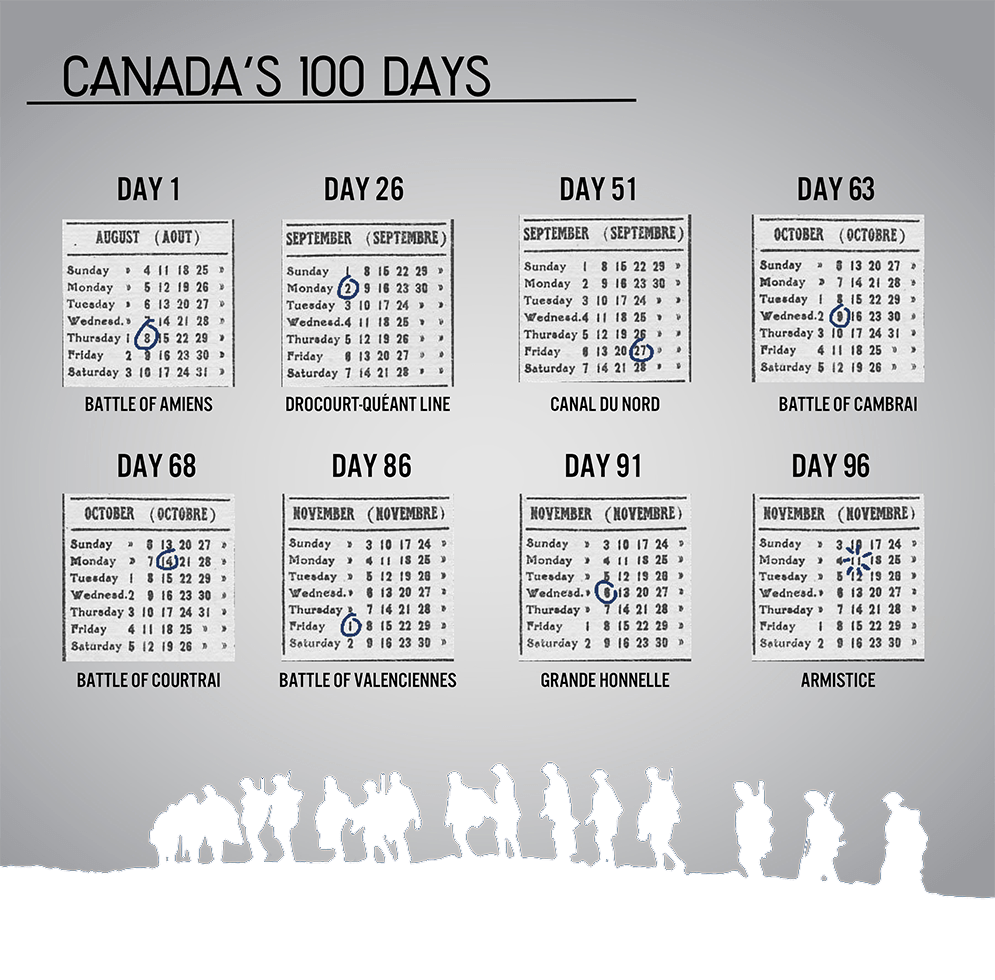From the End of the War to Versailles
The Beginning of 1918: the Failed German Spring Offensive
After the downfall of the Tsar, the Russian Bolshevik government signed a peace treaty effectively ending the war on the Eastern Front, allowing the Germans to transfer a million men to the fighting in France and Flanders.
Attempting to win the war before the Americans arrived in strength, Germany launched a series of attacks that saw the deepest advances along the Western Front of either side since 1914. Initial panic was replaced by stiff Allied resolve and counterattacks. Canadians were not involved in this fighting as they were holding the line elsewhere. Germany was unable to supply their advancing troops, who, in some cases, began to starve. Exhausted, exposed, and unable to replace their hurt soldiers, the Germans had gambled and lost.
The Allied forces (French, American, and British) developed the first use of combined arms (tanks, artillery, airplanes, and infantry) and quickly recaptured most of the territory lost in the German Spring Offensive.
The Americans joined on April 6, 1917. In response to the German sinking of American ships, the U.S. joined the Allies. This tipped the balance in favour of the Allies. By early 1918, 10,000 men began arriving from the U. S. every day.
With casualties mounting overseas, Prime Minister Sir Robert Borden pushed for conscription to make up for the recruiting shortfalls required to fill the ranks of the Canadian Corps. Heated debate raged across Canada for a year and sparked riots. The resulted in a forced election and led to Canadian women earning the right to vote.

The Last Hundred Days? Well, 96 days.
Between August 8th, 1918 and November 11th, 1918, the Allied forces led a series of successful attacks on the Western Front. The Canadian Expeditionary Force had become known as ‘shock troops’ and they played a crucial role in the defeat of Germany and its allies in the last days of the war. The name ‘shock troops’ comes from the literal translation of the German word Stoßtrupp and is used to describe highly mobile troops sent as reinforcement to critical battle points to provide a quick and strong attack.
German troops were pushed back from Amiens, France to Mons, Belgium in under 100 days by a fast-moving infantry force supported by tanks, aeroplanes and a well-coordinated artillery. The retreating German troops were unable to retaliate and their morale progressively worsened.
THE BATTLE OF AMIENS
THE BEGINNING OF THE END, AUGUST 1918
The Battle of Amiens, August 8-11 1918, was the opening battle of the Allies’ final offensive. Canadian and Australian troops led the way with a highly successful surprise attack, advancing 20kms in three days. The commander of the German Army referred to August 8th as “the black day of the German Army.”
Canadian casualties: 1,036 killed and 2,803 injured
Canadians taken prisoner: 29
Allied casualties: 19000 killed or injured
German casualties: 26,000
RMR casualties: 280 (70 killed in action, or died of wounds)
DROCOURT-QUÉANT LINE
August 26, 1918 to September 3, 1918
In the Second Battle of Arras, the Allies continued their rapid advance, breaking through the outer defenses of the German Army’s most formidable defensive system, the Hindenburg Line. The Hindenburg Line was a series of defensive fortifications built in the winter of 1916 with concrete, steel and barbed wire. These defences ran several kilometers front to back. The Germans believed it could not be broken.
Breaking through the Drocourt-Quéant Line in the Second Battle of Arras was an important step towards breaking the Hindenburg Line.
CANAL DU NORD
27 September to October 2nd 1918
The Allies organized a simultaneous attack on the Hindenburg Line at the end of September, 1918. The Battle of Canal du Nord was one of the four attacks and was led by the Canadians.
General Currie, commander of the Canadian Army, had devised an audacious plan to smash through the German defensive positions at the Hindenburg Line. At Canal du Nord, the entire Canadian Corps of 100,000 men pushed through a gap barely a kilometer wide and overwhelmed the Germans.
THE ARMISTICE AND THE END OF THE FIRST WORLD WAR
NOVEMBER 11, 1918
From October to November 11th, 1918, the Canadians and other Allied troops marched steadily forward, liberating Belgium town by town. The Germans had to surrender.
In the last days of the war, the Canadian troops liberated Mons, Belgium, a town of symbolic importance because it had been lost by the British at the beginning of the war in 1914.
The Armistice was signed on November 11th, 1918 and at 11:00 am the fighting stopped. It took a further six months to negotiate the Treaty of Versailles, which was signed on June 28th, 1919. The Canadian war record earned Canada a separate signature on the Versailles Peace Treaty, signifying that national status had been achieved.
Canadian participation
619,636 men served in the Canadian Expeditionary Force, including 424,589 who went overseas.
172,950 were wounded
3,842 taken prisoner
66,665 were killed
RMR
“By war’s end, of the 6,270 who had worn the RMR badge, three-quarters were casualties, and over half had suffered serious wounds.”
1,192 killed
1 executed
3,277 wounded
World
9 million deaths (people in uniform)
13 million civilian deaths
TOTAL: Over 20 million people DEAD
(Canada’s population today is 34 million! Canada’s population in 1914 was only 8 million)
Overview of WWI Medals
Different medals were awarded to war heroes during this conflict. Discover a few of them!

Versailles: A seat at the table
Although a cease-fire was agreed upon in November 1918, World War I officially came to an end with the signing of the Treaty of Versailles on June 28, 1919. Reflecting a true “world war,” 32 countries were invited to discuss the conditions of peace and to decide a conclusion to the war. The main Allied powers who had conducted the fighting and defeated the Central Powers, however, retained a position of privilege, meeting privately and only presenting their suggestions to the other countries on a weekly basis. Germany was not invited to the conference.
Canada, having proved itself in the First World War, gained the right to sign the Treaty of Versailles separately from the United Kingdom and was awarded its own seat in the League of Nations, despite the fact that it was still a Dominion of England. For Canada and the other Dominions, these were important steps towards gaining control over their external affairs. In the years that followed, Canada gained even more independence in its international relations. In 1931 the United Kingdom passed the Statute of Westminster, which officially allowed Canada and the other Dominions to take control of their own foreign policies and to decide independently whether or not to enter into war. When World War II began and Great Britain declared war on Germany, Canada waited one full week before also declaring war, in part to demonstrate that they were joining of their own initiative.
New Borders for the Old World
As the war came to an end, many nations had their borders modified. Empires disappeared to make space for more nation states. Victorious nations made territory gains and the unstable political landscape brought about by the war prompted revolutions and declarations of independence in some parts of Europe.
